A question of geography
There is no doubt that ladies’ mechanical timepieces have been selling well these last few years because they are, above all, beautiful wristwatches. But do women really care whether the inside of their watch has a mechanical or a quartz movement? Do they even know the difference?
“I am afraid that many women don’t have any idea about the difference between a quartz and a mechanical movement when they enter our store,” explains Priscilla Newman, owner of The Watch Gallery in Barcelona Spain, which carries over 30 top watch brands. “There are some women who appreciate mechanical watches, but not many. I am afraid that, on the whole, they prefer the price and practicality of a quartz watch.”
In Asia, knowledge and appreciation of mechanical timepieces fluctuate greatly according to the region, as Michael Tay from The Hour Glass explains, “Women in Singapore are particularly knowledgeable about horology and to a lesser extent, in Thailand. So, in these regions, we do see more interest for ladies mechanical watches. However, for other markets in the region, such as Malaysia, Indonesia, Japan, Hong Kong etc, they are not as discerning about mechanical movements so quartz versus mechanical is not an issue. Overall, aesthetics and budget remain the most important factor.”
At Levinson Jewelers in Florida in the United States. “Many of our female customers know the difference between quartz and mechanical movements,” shares co-owner, Robin Levinson, “a limited amount are intrigued and seduced by mechanical movements.” Although “usually a timepiece is something they want to own regardless of the movement.”
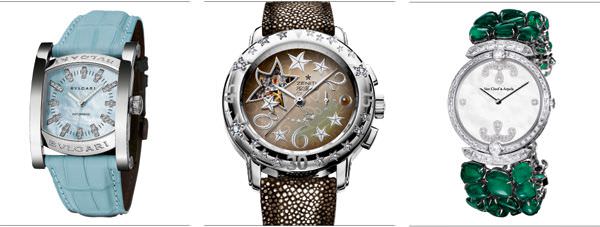
ASSIOMA COLORS by Bulgari, Automatic movement with 42-hour power reserve
STAR OPEN SEA STEEL & DIAMONDS by Zenith, Manual chronograph with power reserve
BELLA by Van Cleef & Arpels, Manual movement
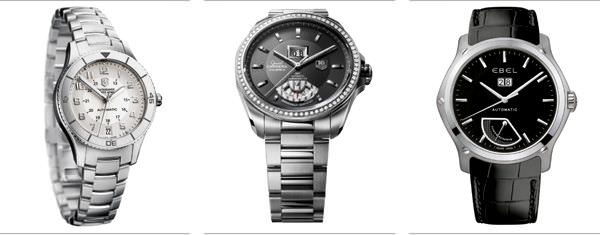
AMBASSADOR CLOUS DE PARIS by Victorinox Swiss Army, Automatic movement with date
GRAND CARRERA by TAG Heuer, Automatic movement with GMT and big date
CLASSIC HEXAGON by Ebel, Automatic movement with big date and power reserve
Brand excitement
The brands have been excited about the women’s mechanical segment for a number of the years now, even if retailers have been less enthusiastic. The watches are obviously selling through or the brands surely wouldn’t continue to develop this segment with such fervour.
Omega, for example, has just launched a new movement, its Co-Axial calibre 8520/8521, especially with smaller ladies’ watches in mind. Omega is excited about its ladies’ mechanical collections. The company believes that there is a real need for ladies’ mechan-ical watches as women have started becoming more interested in the technical features. A growth, they say, that reflects a welcome trend among women to develop stronger identities as they want timepieces which are qualitatively every bit as good as men’s.
Armelle Colangelo, Public Relations Manager for Ebel has noticed an increase in the popularity of ladies mechanical watches, especially in Asia. “More and more women are becoming interested in watchmaking, in the technical and mechanical features of a watch. [In Asia,] they have always been very particular in their aesthetic choice. They like pure authenticity, design and perfect shapes,” she explains. “If this aesthetic aspect is a key feature for women, the technical aspect is no longer neglected and will become an even more important element in the choice of a watch.” Ebel’s production is predominantly quartz, but the company has a new women’s mechanical project in the pipeline for 2009 for its Hexagon line.
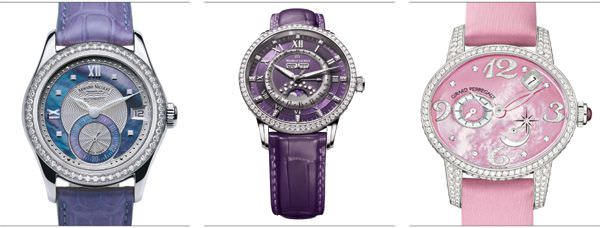
M03 by Armand Nicolet, Automatic movement with date and small seconds
MASTERPIECE PHASE DE LUNE DIAMONDS by Maurice Lacroix, Automatic movement with day, date, month and moon phases
BREAST CANCER AWARENESS CAT’S EYE by Girard-Perregaux, Automatic movement with date, small seconds,power reserve
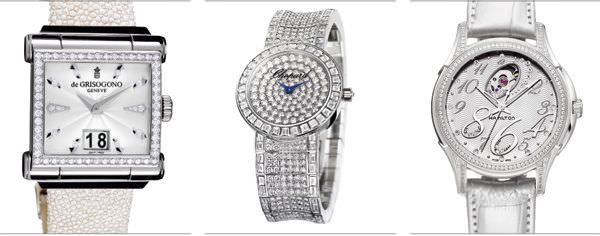
INSTRUMENTO GRANDE by De Grisogono, Automatic movement with big date
DIAMOND TIMEPIECE by Chopard, Manual movement
JAZZMASTER LADY by Hamilton, Automatic movement
How did this niche evolve?
So why did the brands start putting mechanical movements in women’s timepieces? “The reason for the rise in mechanical watches for women is due to the fact that the current fashion is to wear big timepieces, which were initially created for men,” explains Fawaz Gruosi, CEO and President of De Grisogono whose women’s mechanical collection counts for 80 per cent of production. The company’s first unisex watch, the Instrumento No. 1, was mechanical and a huge success right from the start.
“Many of the watches being offered are already men’s watches,” says Levinson. “The ladies are wearing the men’s sizes. Sometimes there are diamonds added, but the style is the same. For example, I have a Franck MÜller 5850 perpetual calendar that was a man’s model, but I added diamonds to the case and – voilÀ – unisex.”
Now many brands have gone one step further by designing mechanical watches especially for women. They remain larger in size, but are more feminine in design. However, the male inspired models are still a huge hit with many women, even if the design is of more interest than the mechanical movement.
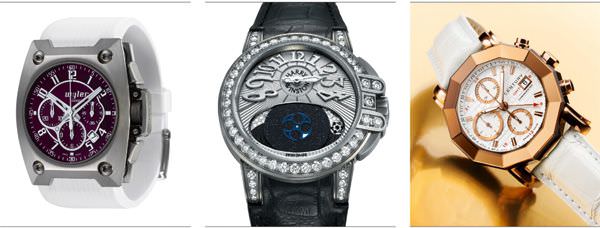
CHRONOGRAPH by Wyler Genève, Manual chronograph movement
LADY Z by Harry Winston, Manual movement
PRIME TIME EGOS by Century, GMT and chronograph functions
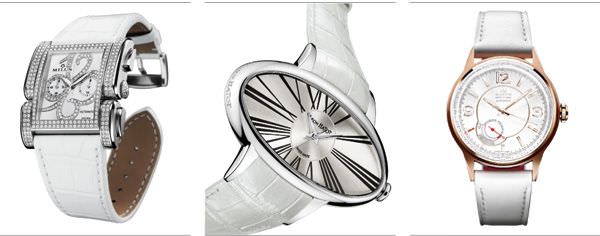
APIANA CHRONOGRAPH by Milus, Automatic chronograph movement
LA GARCONNE by Léon Hatot, Automatic movement
M104 by Marvin, Automatic movement with power reserve
Men are from Mars, women from Venus
Are there real differences in gender when it comes to appreciating mechanical watches? Or are women just a few years behind the men’s mechanical craze? “Personally, I believe that mechanical movements are a difficult sell to the female customer” says Robin B. Krinzman, Brand Designer. “However, there is a niche market and customer. As with the men’s market in the 90’s, the market matured and men bought more watches; their desire for more sophisticated watches followed. It is not exactly the same for women but there will be a maturing of the feminine market as well.”
When it comes to buying a watch, there are differences between the sexes; women are more dream-orientated and buying a watch can be far more emotional. They often have multiple roles, juggling careers, family and friends. They look for a timepiece that corresponds to all these different areas of their lives, an object that expresses their personality, of who and what they are and feel at the time.
Another difference is that women have always loved jewellery and a watch is often seen as an extension of jewellery for them, which is a very different approach to a purchase than that of a man.
“Women are unfortunately still more ‘brand’ orientated than men, who can be receptive to unknown brands if the product is technically interesting…for the guys, often the longer the caption, the more they fall in love, ” observes Cristina Thévenaz, CEO Delaneau. “For us, we need to fall in love with the aesthetical aspect and then if we discover that there is more to the watch, it can create a real attachment and pride in wearing the timepiece.”
Women are often more open to being guided by a salesperson, in comparison to men who have a tendency to enter a store with a reference number, so the shopping experience is all that more important and the possibility of knowledge sharing even more significant.
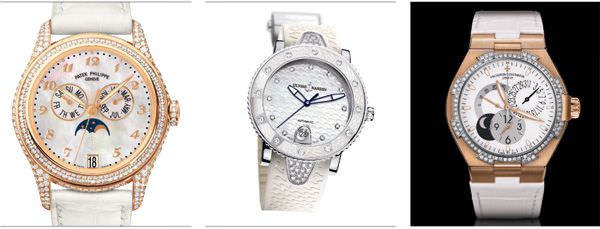
REF: 4937R by Patek Philippe, Manual annual calendar and moon phases
LADY DIVER by Ulysse Nardin, Manual movement with date
OVERSEAS DUAL-TIME by Vacheron Constantin, Manual movement, dual time and day/night indicator
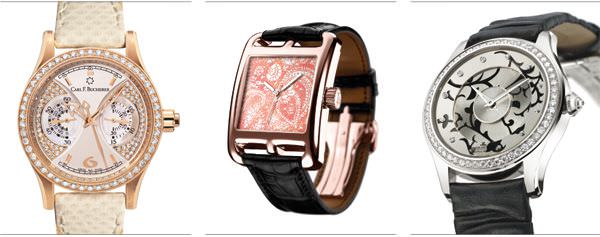
MANERO MONOGRAPH by Carl F. Bucherer, Automatic chronograph
CAPE COD EMAIL GRAND FEU by Hermès, Automatic movement
MASTER TWINKLING DIAMONDS FLORALE by Jaeger-LeCoultre, Automatic movement with 42-hour power reserve
More than a price
When women spend a considerable amount of money on a watch, its value is something that is important to them. Watch auctions have certainly brought attention to the value of watches and women like the long-term value aspect. “Women are very discerning and want to know where the value comes from,” shares Phil Ogle, Director of Sales at Luxury Watch Distribution.
The Watch Gallery's Newman has also noticed the importance of value for women when buying a mechanical timepiece. “It is easier to convince a Patek Philippe client, for example, to buy a mechanical watch as she is seduced by the Manufacture and considers Patek Philippe as a long-term investment for future generations.”
Understanding the value of a mechanical watch is one of the biggest challenges in converting a woman (or a man for that matter) from quartz to mechanical. The watch may look exactly the same on the outside, but the price can differ dramatically. It is for this reason that the client needs to know where this additional value comes from.
A great number of brands equip their ladies’ mechanical watches with exhibition casebacks or cut-out dials. This is not only to expose the beauty of the mechanical movement, but also to emphasize the value of the mechanical element. A similar example has been seen with the tourbillon. For many watch aficionados, a hidden tourbillon doesn’t have a fraction of the appeal of one proudly on display.
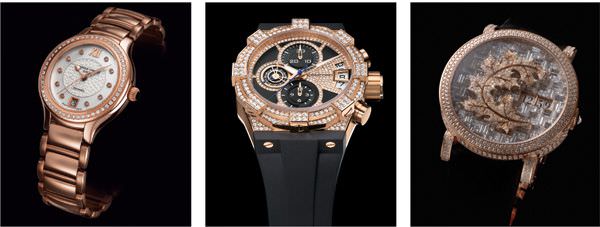
DELIGHT® by Frederique Constant, Automatic movement with date
C1 CHRONOGRAPH by Concord, Manual chronograph with date and power reserve
AMAZONE 1608 HOLLY LEAF by Delaneau, Automatic movement
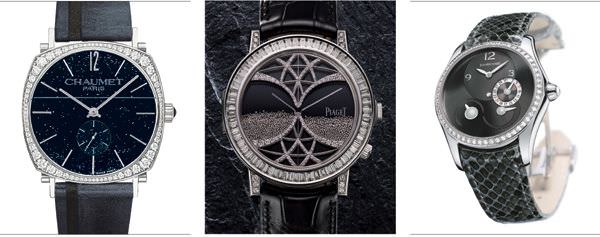
DANDY by Chaumet, Manual movement
LIMELIGHT PARIS-NEW YORK SECRET WATCH by Piaget, Manual movement
BRESSEL LADY by JeanRichard, Automatic movement with date and power reserve
Sharing the magic
The secret in tapping into this niche market is to discover ways of sharing the magic of mechanical watches with women. Even someone who is unaware of the difference can be seduced by such movements and appreciate the beauty of an object that is meticulously crafted all the way through. This is the essence of luxury. A mechanical movement isn’t a necessity – a quartz movement would, for the most part, actually do a better job at keeping accurate time – but it is a wonderful indulgence. The pleasure comes in the knowledge that the watch is exquisitely crafted in every detail, even if it is something that can’t be seen on the outside. “Women are attracted to a watch at ‘first sight’, but the product needs to be studied further and has to prove its looks in every detail,” says Jan EdÖcs, President and CEO of Milus International SA. “Women are curious and mechanical movements give a watch a more complex dimension. Women tend to live through emotions and love and are keen on wearing a watch with a sophisticated mechanism combined with elegance and uniqueness in design.”
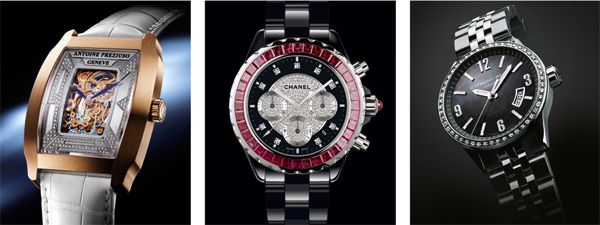
OLTRE TEMPO by Antoine Preziuso, Manual movement
J12 JOAILLERIE by Chanel, Automatic chronograph
FREELANCER by Raymond Weil, Automatic movement with date
Telling a story
So how can a retailer sell a mechanical watch to a woman who has only ever worn quartz? It is no easy task, but like with many luxury products, women are fascinated by the story.
“Women are passionate and yet so many retailers sell the advertising and not the passion,” shares Phil Ogle, “We recently sold a Jean Dunand Orbital Tourbillon to a woman and she grew in the intrinsic knowledge of it - the more she learned the whole story - the more she fell in love with it.”
“Unfortunately, retailers still sell to women through the brand names or through the aesthetical aspects,” remarks ThÉvenaz, “Women need to be guided by the retailers to regard the watch as an object with specific characteristics and not just an accessory with a name on it – like another handbag.”
Anyone who has ever toured a watch factory in Switzerland will know how impressive it is to see watchmakers assembling a mechan-ical watch by hand. The work that goes into constructing a movement – without taking into account the time required to produce the parts - can range from a number of days to a number of years. This human touch brings a romantic element to an object that may have started its life in the snowy mountains of Le Locle before ending up on the wrist of someone living in sunny climes on the other side of the world. This is the aura of Switzerland, the history, the know-how and the patrimony that can be an important selling point when explaining how a mechanical movement is made. The craftsmanship is also a fascinating element of a mechanical watch. The fabri-cation element of a movement combines so many different arts, from the design and assembly to the polishing and finishing of the different parts. Put a loupe to a client’s eye and watch her get lost in the inner world of the movement and discover the beating heart of a watch.
Making the transition
There is no doubt that women are becoming gradually more knowledgeable about mechanical watches, but it is still a very slow process, despite the plethora of choice in the shops. Even if women are buying mechanical watches, the stores are reporting that it is mainly the aesthetics and the price of the watch that are of most importance in a sale. But with the right education from the brands and retailers, this can change and we can look forward to more female customers making the transition from quartz to mechanical. And once they change, they may not want to go back. As Phil Ogle comments, “When the true expression of a mechanical watch is shared and embraced by women - the story, passion, emotions and tradition - many are left short changed with quartz.”
Source: Europa Star August-September 2008 Magazine Issue








